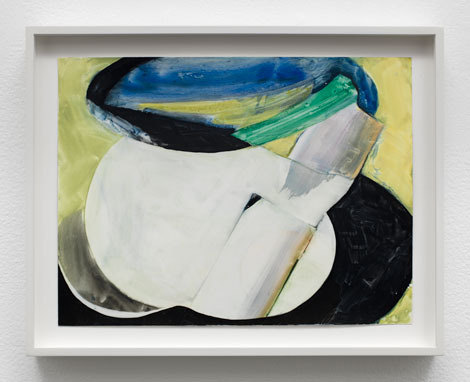Your cart is currently empty!
Lesley Vance

Lesley Vance’s work may at first read like Diebenkorn in miniature, but her solo show quotes midcentury abstraction in a distinctly Reagan-era palette; little messages from the 1960s retold in twilight Cold War parlance. The gallery walls nearly swallow her small canvases, making it seem, as one approaches them, that heading back in time is a side effect of heading closer.
Vance’s unframed and minimally-framed watercolors and oils recall a show mounted at the end of a workshop. Like a master class in aesthetic compression and intimate proportions, her work lays bare a learning process, each piece a tiny exercise. The smaller size of Vance’s work, one of its most distinct features, imparts a cryptic informality.
One untitled oil on linen (all works 2013) has the psychic insistence of de Chirico and assertive lines of Miró, but is rendered in sedate milky grays. Vance adds dense articulation and finely-honed detail to far corners of her canvases, sudden clues that don’t seem to add up. Her inconsistencies are bold—another untitled oil on linen mimes the bulky symbolism of the early 20th century but in neon and black oils, more akin to Schnabel and Longo in their cool ’80s heyday.
The corner office of American Psycho’s Patrick Bateman might have been furnished with some of Vance’s more aggressively-composed pieces; however, their smaller size competes with their violent pathos. Dynamic shapes whip through, and indeed they appear brusquely wiped off of Vance’s grounds. The energy is hot, yet surrounded by such massive swaths of white gallery wall as to impart more an urgent whisper rather than a scream, a battle fought on a scale to which we are only just being introduced.
Vance does not want to devour you with scale and inevitability, but instead quietly ushers you through a cache of finished works that mimic studies. Using suggestion and possibility in place of hard-edged narrative, her work holds back more than it offers up. Circling around hallowed California abstraction and ’80s materiality, Vance leaves only tantalizing hints of both, as if footnotes to a larger opus.
Some of her canvases may contain still lifes, however their legibility is too elusive to be certain. Alone, in designs dictated by unfamiliar syntax, afloat in shapes and fields of color, the viewer is permitted to time travel, but without an assured sense of direction. Vance’s is a new aesthetic language without recognizable objects as glossary and guide. Her canvases are small maps where inner and outer space overlap, as do the artistic forays of the 20th century’s last decades. Such massive movement of emotional and temporal capital pays, but is not guaranteed by any gold standard that we can decipher.
The take-away message of Vance’s solo show is suspect, and to wonderful effect. Like entering a time travel machine with crossed wires, Vance purses together decades across time and space. Mixing emotional registers just as liberally, she makes a balance sheet that doesn’t quite add up, but produces a feeling so curious as to be unmistakably pleasurable.